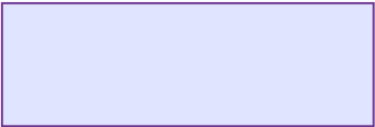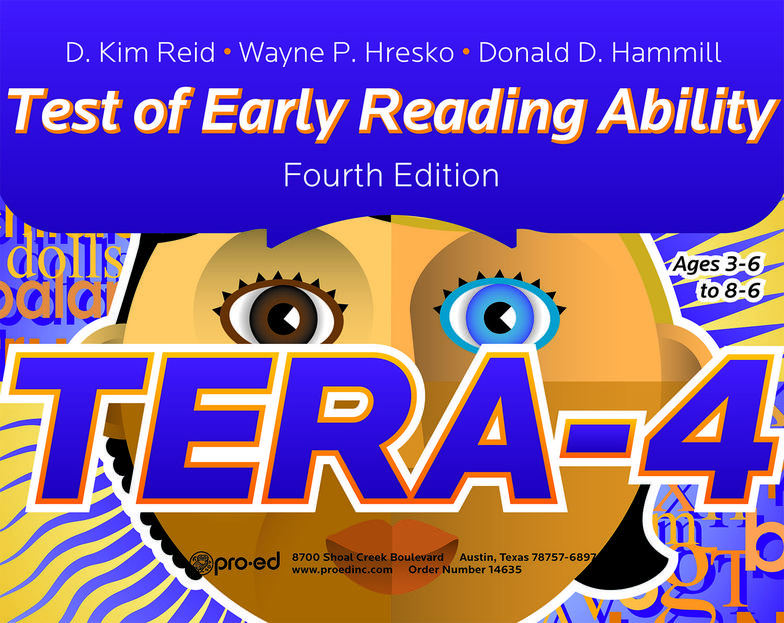NEWS & PROMOTIONS
Test of Early Reading Ability - 4th Edition (TERA-4)
D. Kim Reid • Wayne P. Hresko • Donald D. Hammill
Ages: 4.0 - 8.11 years
Testing Time: 30 minutes
Administration: Individual
Scoring: Manual or Online
TERA-4-1 Complete Kit . . . . . . . . . . . . . . . . . . . . $394.00
TERA-4-2 Examiners Manual. . . . . . . . . . . . . . . . . . .$97.00
TERA-4-3 Picture Book (A&B). . . . . . . . . . . . . . . . . $171.00
TERA-4-4 Form A Examiner Record Booklets(25) . . . .$63.00
TERA-4-5 Form B Examiner Record Booklets(25) . . . .$63.00
COMPLETE TERA-4 KIT INCLUDES: Examiner’s Manual, 2 Picture Books (Form A and Form B), 2 packets of 25 Examiner Record Booklets (Form A and Form B), and Reader.
User Qualifications Required ... See Order Form Here
The Test of Early Reading Ability–Fourth Edition (TERA-4) is a direct measure of reading ability in children ages 4-0 through 8-11. Rather than assessing children’s “readiness” for reading, the TERA-4 assesses their mastery of early-developing reading skills. The test has three subtests: Alphabet (measures knowledge of the alphabet and its uses), Conventions (measures knowledge of the conventions of print), and Meaning (measures comprehension of print). A composite, called the General Reading Index, represents overall reading ability.
All users now have access to the new optional PC-, Mac-, Chromebook-, and tablet-compatible TERA-4 Online Scoring and Report System via activation codes included in each package of TERA-4 Examiner Record Booklets. This system is a quick, efficient tool for (a) entering test session data; (b) converting subtest item scores or total raw scores into scaled scores; (c) generating composite index scores, percentile ranks, and upper and lower confidence intervals; (d) comparing TERA-4 scores to identify significant intraindividual differences; and (e) obtaining a score summary or narrative report. Use of the software ensures accurate application of basals and ceilings and calculation of scores.
- Demographics: The TERA-4 was standardized on a representative sample of 1,025 children representing 29 states and 271 different zip codes.
- Reliability: Extensive studies of test reliability (coefficient alpha, test-retest, immediate and delayed alternate forms, and interscorer) support the TERA-4’s use with individual students. Average coefficient alphas for the full normative sample range from .88 to .97 for subtests and is .98 for the composite.
- Validity: Content-description validity was established through careful selection of items, controlled vocabulary, construct review by a panel of language experts, conventional item analysis, as well as analysis of the test floors, ceilings, and item gradients, and differential item functioning. Criterion-prediction validity was established by (a) correlating TERA-4 standard scores with commercially available measures of reading ability (i.e., ERA, TOSWRF-2, TOSCRF-2, and TOSREC), (b) comparing means and standard deviations between TERA-4 and criterion tests, and (c) computing sensitivity, specificity, and ROC/AUC statistic. Construct-identification validity was established by studying (a) the relationship of the TERA-4 standardized scores with age, academic achievement, spoken language, and intelligence; (b) the ability of the TERA-4’s standard scores to differentiate groups with known reading problems from those without such problems; and (c) the factorial fit of the subtests to the construct in the test model (i.e., reading). Floors, ceilings, and item gradient analyses for the TERA-4’s subtests and composite were conducted.











